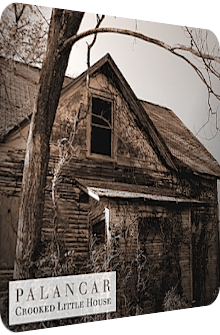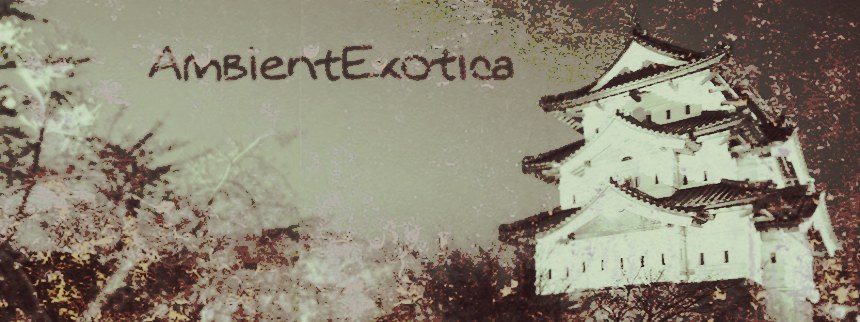
Palancar
Crooked Little House
2011
I visit and review material of the Earth Mantra label on a regular basis, statistically every eleventh week or so, but what I have not reviewed thus far is a work by the label’s former owner and curator, Darrell Burgan aka Palancar who hails from Texas, presents the darker and more mysterious realms of the Ambient genre and has only recently handed the label duties to the Relaxed Machinery label founder John Koch-Northrup in April 2013. All works of the Earth Mantra label remain available for free, it is not any different with Crooked Little House, originally released in 2011 and my favorite album by Palancar. It is available to download at Earth Mantra’s label page. Crooked Little House comprises seven tracks, all of them quite long and progressive, and as it turns out to the follower of the label, it is basically a prime example of both Burgan’s stylistic focus and his aesthetic views. Oscillating between Space Ambient, New Age, enigmatic Dark Ambient sceneries and a pinch of esoteric crackles and shady blebs, Crooked Little House is created with synthesizers, percussion and guitars, the latter of which are seldom unleashed with their original texture intact; they are usually processed, reach regions and create patterns that are surprisingly inventive. While the title and the front artwork may imply that the house provides the thematic arc, I do not share this notion due to the wideness of the arrangements, the constant progression that marks its actual morphogenesis and the ever-changing shifts in the layers and textures. This little house is too small for this wealth of wideness and does not mirror the cavernous or spacious results. Read more about all seven tracks, the album’s many strengths and minor flaws below.
The Darkest Evening Of The Year may be the portentous title of the opener, but there is nothing overly baneful in-between the intrinsic layers of Palancar’s gateway to the jinxed house as of yet. In fact, the mood turns out to be fueled by a surprisingly mellow mystique with less traces of gloom and horror than one might imagine. Launching the track with glaringly frosty but absolutely amicable vibraphone-esque sine chimes plus additional whistles, plinking bells and misty 8-bit bass accentuations, this blazingly luminous artifact is awash with light and snugness. Since Darrell Burgan creates progressive and shifting pieces, rest assured that this winterly phase of quiescence and tranquility will not be maintained forever. And sure enough is a low drone gale interwoven soon, the first precursor of a calamitous event. Its impetus and voluminosity increases, and worse, the chinking chimes fade out eventually. Since they are so piercingly pristine, they can be heard for several minutes, even when their presence has already decreased to an infinitesimal sliver, but there is no doubt that the brazen machine-like drone gusts and metallic legato buzzes have taken over the atmosphere with their semi-monotony and only the slightest hints of halftones. This is still no terrifying composition, even when the last melodious remnants may have vanished. The ensuing windscape is comparably genteel and not tempestuous at all. This is not the only track that cannot be easily equipped with the Dark Ambient tag. The following eponymous Crooked Little House is similarly well-mannered. Admixing vinyl clicks to a multilayered haze of whitewashed pink noise structures, altered guitar drones and rhythmical stop-and-go motions which tear the streamlined atmosphere apart, Palancar gets rid of the well soothing loop in favor of a drone layer full of electric buzzes, crackles and traversing snake-like shakers. Fuzzy heater blowers round off the curiously dreamy state.
Residue (Afterwards) follows, and nope, it is yet again no pitch-perfect example of a Dark Ambient track and rather resides in New Age-oid climes with its acroamatic polar light streams, the echoes of wooden claves or goblet drums as well as the glistening of aqueous vesicles. Similar to a dripstone cave, this track covers its murky backdrop with ebbing and flowing drone layers which float by, each of them with its own surface and timbre. Even though Residue (Afterwards) is much more contemplative than spine-tingling, it is somewhat alienating and glacial due to the insectoid scuttling crackles and hints of cacophony. The album gets increasingly darker with each track, and it so happens that the eeriest hallmark of this particular composition comprises of a György Ligeti-resembling faux-choir which basically consists of a screeching electric guitar; it is tweaked in such a way that it sounds like a lamenting chant of a female singer. A great illusion! Up next is Falling Free, and when it comes down to nailing its aesthetic characteristics, I would compare this piece to Francisco López’s and Thomas Köner’s nature-driven field recordings. This is a windy Drone track par excellence. It is grey-tinged, definitely wadded and bolstered, streamlined and silkened, blurred and diffuse. Geiger counter frizzles are the only staccato elements that tower above the continuous stream of airflows. I presume that whatever source Palancar recorded, it was slowed down and stretched almost ad infinitum. This could explain the several metamorphoses and gradual mutations, tense moments and the concluding balm-resembling peacefulness. Drone fans who like their music to be melody-free and enigmatic ought to be delighted.
Three Threes is the galactic track of the septet and presents the well-known aural eeriness of space, vastness and emptiness. Launching with the rhythmical blows of strong winds and intermixed gas cooker flames, the arrangement then consists of a surprisingly warm and 60’s-evoking guitar layer which oscillates and wobbles in adjacency to acidic square lead klaxons. Their inclusion turns out to be the biggest flaw of the track – or even the whole album – for one reason only, namely their all too insisting presence that kills the opulent superstructure of arcane synth crystals and reciprocating flecks in the distance. When these square lead pads are finally gone for good, the backdrop has changed as well, now being pieced together by airplane engine-resembling rivers and the warm euphony of two thin guitar layers. Three Threes has all the potential in the world, but ultimately fails due to balancing problems. Valley Of The Shadows is more successful, moving from click-dispensed dark wind panoramas over wobbling electricity placentas to sine tone coercions that resemble the vibraphone setting of the opener. The shuttling structure of these sine erections drones remarkably perspicuous and leads to the final composition named Peacefulness. The title is a malevolent red herring, for this is a proper Dark Ambient track with a buzzing tension, New Age flute tones that seem to derive once again from a guitar rather than real reeds, and high-plasticity clicks, crackles and cuts. The flute melody is deeply entangled with the dusky synth strings which rise in suspense and change their tonal color palette ever so slightly. Additional gongs, glittering devices and sprinkler-like insect sounds evoke a looming gamelan aura that is crestfallen, terrifically abyssal and independent. Palancar fathoms out the depth in this New Age-focused Dark Ambient piece and makes it a mesmerizing example that even lightens up at the end, at least in the given context, by injecting a Middle Eastern (!) guitar mystery which swallows the listener due to its sun-soaked heat. A blast!
Crooked Little House is haunting. Darrell Burgan achieves this with carefully interwoven textures, but this is a feat many other Drone producers are capable of. In the end, I can explain my devotion for this work with the lack of bold guitar layers. I think the guitar is used in much more cases and loops than I could ever imagine, but it is tremendously camouflaged or masked, sometimes resembling an ancient flute or even an Oriental oud, at other times being almost slowed down to a complete halt. The synth surfaces are more important in the Texan artist’s work than grinding guitar layers or horrific shockers. This is no proper Dark Ambient album, not even in a wider sense, but it has that certain mystique, positive esotericism, New Age spirit and that Space-Age mentality. These four columns are not accidentally meshed in this work. Burgan was, after all, the curator of the Earth Mantra label, and it seems to me that his album is built on the many styles and subgenres he so regularly features and supports. There is only one dud, and that is Three Threes due to the unbalanced volume levels and the harshness of the gargantuan square lead concoctions that tear apart the otherwise successfully maintained feeling of being in space, or alternatively, in a space which is extrinsic and strange. There are, on the other hand, three very successful and unexpected pieces. The opener with its hibernal white contrasts, vibraphone scintillae and only the slightest hints of darker undertones, then the the finale with a clear nod towards darker Ambient schemes and a great duality of sunny heat with a still awkwardly uncomfortable oppressiveness, and Falling Free with its strict melody-less Drone nature full of various winds. Another important mention and maybe even the greatest short-lived inclusion of the album would be the artificial chant sequence in Residue (Afterwards) which reminds of orchestral works, but is surely created with a guitar. Crooked Little House is one of these albums I keep coming back to very often. It is strangely benign and its darker accents are milder or more mysterious. Dark Ambient fans should download this album nonetheless, as its thick atmosphere is strongly encapsulating. New Age fans should do the same. A hidden gem, though easily available!
Further listening:
You can download the album for free at Earth Mantra’s label page.
Ambient Review 207: Palancar – Crooked Little House (2011). Originally published on Apr. 24, 2013 at AmbientExotica.com.
